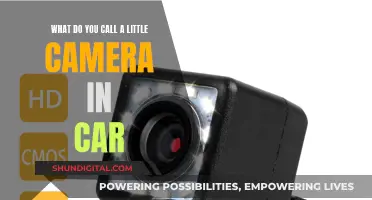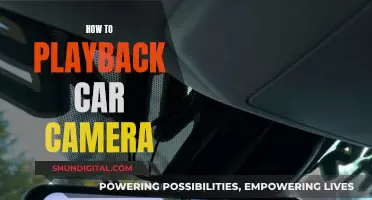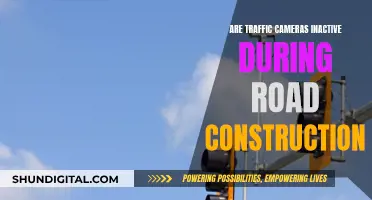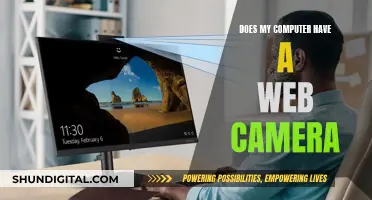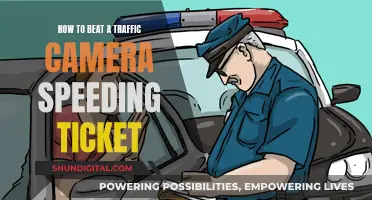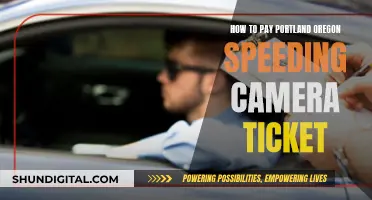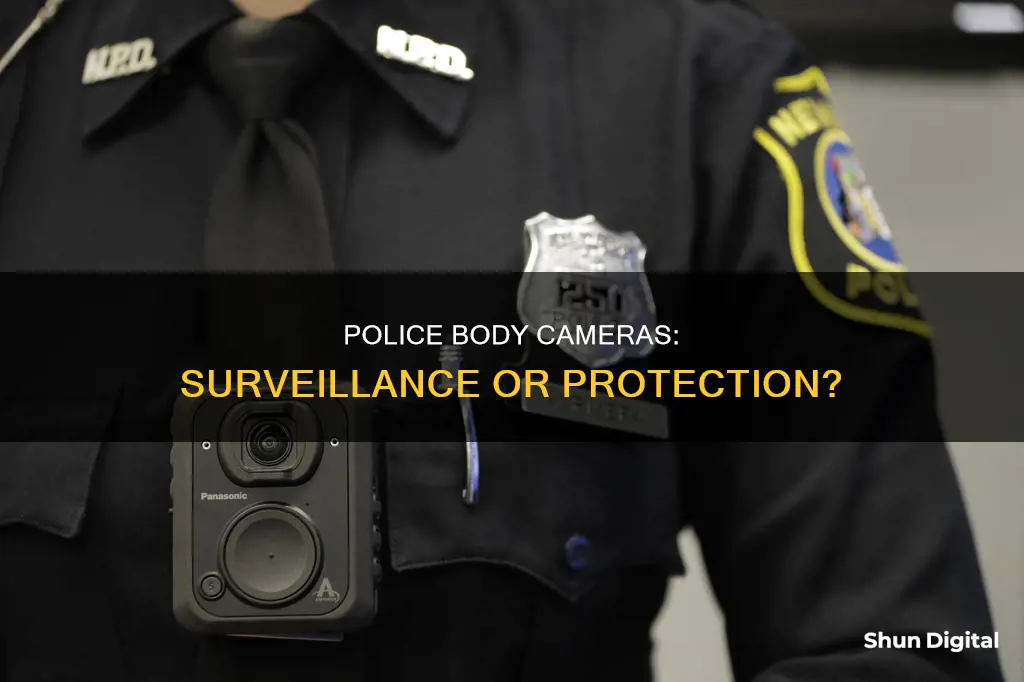
Police cameras are a type of surveillance camera used by law enforcement agencies to monitor and record activities in public spaces. They can be body-worn cameras or mounted on vehicles, buildings, or poles. These cameras have advanced features such as pan, tilt, and zoom capabilities, infrared vision, and facial recognition technology. While they are touted to improve officer safety, increase evidence quality, and reduce civilian complaints, their effectiveness is debated, and concerns about privacy and civil liberties have been raised. The ease of access to surveillance tools by police departments and the lack of consistent regulations across states in the US have further complicated the issue.
| Characteristics | Values |
|---|---|
| Use | To monitor protests, communities of colour, and criminal activities |
| Placement | Outside homes, on streets, in neighbourhoods burdened by violence, at gas stations, in business districts, and police vehicles |
| Ownership | Government agencies, local business associations, private companies, individuals |
| Types | Bullet, dome, pan-tilt-zoom (PTZ), mobile surveillance towers/poles, thermal, automated license plate readers (ALPR), body-worn |
| Features | Infrared LEDs, infrared light, tamper-resistant, varifocal lenses, facial recognition, license plate recognition, night vision |
| Access | Police departments, at-home viewers, police officers |
| Benefits | Improved officer safety, increased evidence quality, reduced civilian complaints, reduced agency liability, faster response times, improved situational awareness |
| Concerns | Privacy invasion, lack of oversight, potential for misuse, racial bias, inaccurate identification, data breach |
What You'll Learn
- Police body-worn cameras can be used to improve civility in police-citizen interactions
- Police access to private security cameras can be used to monitor protests and communities of colour
- Police surveillance cameras can be used to monitor compliance with social distancing rules
- Police surveillance cameras can be used to monitor gunshots and dispatch police
- Police surveillance cameras can be used to monitor license plates

Police body-worn cameras can be used to improve civility in police-citizen interactions
Police body-worn cameras are an increasingly common piece of policing equipment, with many police departments and forces worldwide adopting their use. These cameras are typically worn on the torso, pinned to the officer's uniform, and are used to record interactions with the public and gather video evidence at crime scenes.
Body-worn cameras have been viewed as a way to improve police practice and address challenges in maintaining the public's perception of the legitimacy of police actions, particularly in the use of force. Proponents of body-worn cameras suggest that they can lead to increased civility in police-citizen interactions. The presence of the camera and the knowledge that the encounter is being recorded can have a "civilizing effect" on both citizens and officers. Citizens may be more compliant with officer commands and less likely to lodge complaints, while officers may be more cautious in their actions and more sensitive to scrutiny.
Research on the effectiveness of body-worn cameras in improving civility in police-citizen interactions has produced mixed findings. Some studies have shown that body-worn cameras can lead to positive interactions and made people feel safer, resulting in reductions in citizen complaints and increases in early guilty pleas. For example, a study in Boston, Massachusetts, found statistically significant reductions in citizen complaints against police and police use-of-force reports for officers wearing cameras.
However, other studies have found no significant effects or even negative outcomes. A study in Washington, D.C., for instance, found no significant impact on the use of force by officers or citizen complaints. Similarly, a multi-site evaluation of eight departments in the US and the UK found no statistically significant differences in police use of force or citizen complaints.
The mixed findings suggest that additional research is needed to fully understand the impact of body-worn cameras on civility in police-citizen interactions. The context and local policies, such as when officers are required to turn on their cameras and the release of footage, may also play a crucial role in the effectiveness of body-worn camera programs.
Troubleshooting Camera Focus Issues on LG Devices
You may want to see also

Police access to private security cameras can be used to monitor protests and communities of colour
Police access to private security cameras is a contentious issue, with civil rights activists warning of "mission creep". While these cameras are often installed to prevent break-ins, they can be used to monitor protests and communities of colour, leading to a system of warrantless surveillance. This has been a concern in cities like Newark, Baltimore, San Francisco, and Detroit, where police departments have some form of public-private camera system.
In Detroit, the police department expanded its network of CCTV cameras, calling it Project Green Light. While the project was initially intended to monitor gas stations, where a high number of violent crimes were taking place, activists worry that the police are using it for more than just patrolling these areas. This concern is heightened by the fact that the police can analyse images captured by the cameras with facial recognition software, which has led to the wrongful arrest of a Black man, Robert Williams.
Similarly, in San Francisco, during the George Floyd protests in 2020, the police obtained real-time access to a network of private security cameras in a business improvement district, capturing footage of everyone in the area. This type of access to private security cameras can easily be used to target and monitor communities of colour, as has been seen in the past with the FBI's surveillance of civil rights leaders like Martin Luther King Jr. and the more recent surveillance of Black Lives Matter demonstrators.
With the proliferation of cameras and surveillance technology, it has become easier for law enforcement to track and identify protesters and build extensive dossiers on them. This can have a chilling effect on the right to peaceful assembly and free speech, as people may become fearful of potential retaliation or harassment if they are identified by the government.
To address these concerns, some cities have enacted Community Control Over Police Surveillance (CCOPS) laws, which include transparency requirements for the procurement of new surveillance technology and the creation of community advisory committees to establish standards and provide ongoing reporting on the use of this technology. Additionally, some jurisdictions have restricted or banned the use of facial recognition technology by government agencies, and there have been proposals to ban the use of other surveillance tools like geofence warrants and cell site simulators without a warrant.
Powering Up: Replacing Camera Batteries for a Fresh Start
You may want to see also

Police surveillance cameras can be used to monitor compliance with social distancing rules
Police surveillance cameras are increasingly being used to monitor compliance with social distancing rules. During the COVID-19 pandemic, social distancing was crucial to prevent the spread of the virus, and police departments used surveillance tools to ensure that people were adhering to these rules.
In Detroit, for example, police observed that crime was rising, particularly near gas stations. They contacted eight gas stations and installed CCTV cameras that streamed live footage directly to the police department. This allowed officers to conduct "virtual patrols" and monitor compliance with social distancing rules. The Detroit Police Department's Project Green Light has expanded to include over 700 cameras at 500 businesses, and the department has plans to add traffic cameras to the project, bringing the total number of cameras to over 1,000.
In San Francisco, the police department maintains a database of privately-owned surveillance cameras and their locations. During the George Floyd protests in 2020, the police obtained real-time access to the entire camera network, capturing footage of everyone in the area. While the camera system was created to deter property violence, the police took a broader approach and used the footage to monitor compliance with social distancing rules, issuing 35 tickets as a result.
The use of police surveillance cameras to monitor social distancing has raised concerns about privacy and civil liberties. Civil rights activists warn that once installed, these cameras are often used for tasks beyond their original scope, such as monitoring protests, and can become a system of warrantless surveillance, particularly in communities of color. There are also concerns about the accuracy of the technology, as it has been shown to have deficiencies in accurately identifying people with darker skin complexions.
To address these concerns, some cities have implemented regulations and restrictions on the use of surveillance cameras. For example, in New Hampshire, if a car is not associated with any crime or is not being looked for, any footage or data collected must be deleted within three minutes. However, the regulations and penalties for violating them vary widely across different states and cities.
In conclusion, police surveillance cameras can be a useful tool for monitoring compliance with social distancing rules, but their use must be balanced with the need to protect privacy and civil liberties. Clear regulations and oversight are necessary to ensure that these tools are used appropriately and do not infringe on the rights of citizens.
Unveiling Galaxy S10's Live Focus Camera Feature
You may want to see also

Police surveillance cameras can be used to monitor gunshots and dispatch police
Police surveillance cameras are an increasingly common feature of modern life, with local police departments deploying powerful surveillance tools with little oversight. This includes the use of publicly accessible CCTV cameras, automatic license plate readers, and cell phone tracking devices. One of the key justifications for their use is to help reduce crime and improve public safety.
One example of this is the use of ShotSpotter technology, an acoustic sensor designed to detect the sound of gunshots. These sensors are trained to recognize loud, impulsive sounds between 120 and 160 decibels, which could indicate a gunshot or a car backfiring. When a potential gunshot is detected, an alert is sent to ShotSpotter headquarters, where a human listens to the recording and determines its cause. If a gunshot is confirmed, the local police department is notified, including details such as the number of shots, location, and time. This information can then be used to dispatch officers to the scene of a suspected shooting.
The use of ShotSpotter technology has raised some concerns among communities, particularly those with a history of distrust of the police. Some citizens worry that the technology could be used to overhear private conversations, although ShotSpotter and police departments have denied this, stating that it is trained only to recognize loud, sudden sounds. Nonetheless, police must be careful in how they roll out such technologies to avoid worsening relationships with the communities they serve.
In addition to ShotSpotter, police departments have access to other surveillance tools such as pole cameras, predictive policing programs, and cell phone tracking devices. These tools can assist in solving crimes and protecting public safety, but they also raise important privacy and civil liberties concerns. As technology continues to evolve, it is crucial that regulations and oversight keep pace to protect the rights of citizens while also allowing law enforcement to utilize these tools effectively.
Focusing KPC-EJ230 High-Res Bullet Cam: Tips for Crisp Footage
You may want to see also

Police surveillance cameras can be used to monitor license plates
ALPRs can be divided into three categories: stationary or fixed ALPR cameras, mobile ALPRs, and ALPR trailers. Stationary or fixed ALPR cameras are installed in a fixed location, such as a traffic light, telephone pole, or the entrance of a facility. Mobile ALPRs are often attached to police patrol cars, allowing officers to capture data from license plates as they drive around. ALPR trailers are towed to particular areas and left for extended periods to collect data in a similar fashion as fixed ALPRs.
License plate recognition (LPR) cameras are a type of surveillance camera that can capture video and extract numbers and letters from a license plate on a moving vehicle. LPR cameras can capture number plates during the day or night with accuracy thanks to features such as variable shutter speeds, high-contrast video, and headlight compensation. The enhanced quality of LPR cameras is due to built-in infrared sensors that are more sensitive than traditional cameras.
LPR cameras offer several benefits over regular security cameras when it comes to license plate recognition. LPR cameras can process movement (vehicle speed), lighting conditions (bright lights or low light), and distance (lens) faster and better than regular cameras. They can also capture license plates at greater distances and higher speeds.
The use of ALPRs and LPR cameras by law enforcement agencies raises concerns about privacy and the potential for misuse. While these technologies can aid in finding stolen cars and vehicles used in crimes, the vast majority of vehicles captured are not associated with any criminal activity. The collection and retention of ALPR data at a large scale, combined with the lack of regulations and secure storage, pose significant privacy risks.
Foscam Camera Production Origins: Where Are They Made?
You may want to see also
Frequently asked questions
Police cameras are cameras used by law enforcement agencies to monitor public spaces and collect evidence. They can be body-worn or mounted on vehicles, buildings, or poles.
Yes, police cameras are a form of surveillance technology. They are used to monitor and record activities in public spaces, and sometimes, private residences, without individuals' consent.
Proponents of police camera surveillance argue that it helps reduce crime and improve evidence collection. It can also enhance officer safety and reduce civilian complaints and agency liability.
Critics argue that police camera surveillance invades privacy and can be used for unwarranted monitoring, particularly in communities of color. There are also concerns about the accuracy of technologies like facial recognition, which has led to wrongful arrests.


